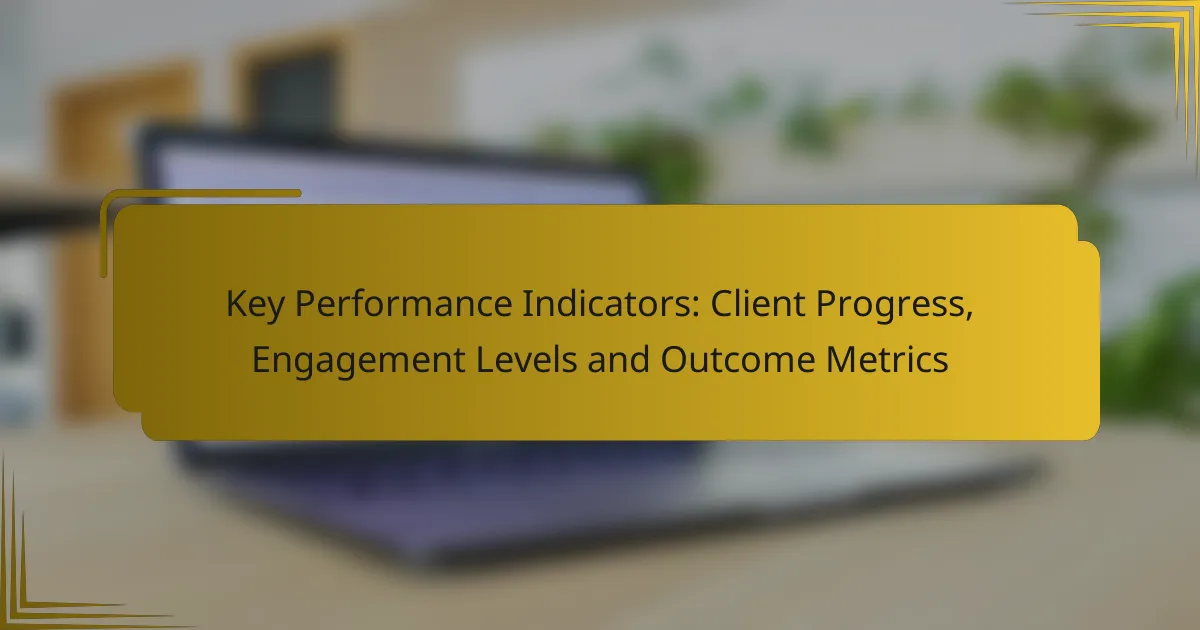Key Performance Indicators (KPIs) are essential for measuring client progress, engagement levels, and outcome metrics. By effectively tracking these indicators, service providers can evaluate the success of their strategies and make informed adjustments. Monitoring client engagement helps gauge satisfaction and communication effectiveness, while relevant outcome metrics provide valuable insights into overall performance and areas for improvement.

How to measure client progress effectively?
Measuring client progress effectively involves using various methods to track advancements, engagement, and outcomes. This ensures that both clients and service providers can assess the effectiveness of their strategies and make necessary adjustments.
Utilize progress tracking tools
Progress tracking tools are essential for monitoring client advancements over time. These can range from project management software to specialized client relationship management (CRM) systems. Choose tools that allow for real-time updates and easy access to performance metrics.
Consider tools like Trello or Asana for project tracking, or HubSpot for CRM. Ensure that the chosen tools align with your clients’ needs and preferences to enhance adoption and usage.
Set clear milestones
Establishing clear milestones helps clients understand their progress and what is expected at each stage. Milestones should be specific, measurable, achievable, relevant, and time-bound (SMART). For example, a milestone could be completing a specific training module within a month.
Regularly review these milestones with clients to ensure they remain relevant and adjust them as necessary based on progress and feedback.
Conduct regular check-ins
Regular check-ins are vital for maintaining open communication and assessing client progress. Schedule these meetings weekly or bi-weekly to discuss achievements, challenges, and next steps. This consistent interaction fosters accountability and keeps clients engaged.
During check-ins, use open-ended questions to encourage clients to share their thoughts and feelings about their progress, which can provide valuable insights for further support.
Implement feedback loops
Feedback loops allow for continuous improvement by incorporating client input into the progress measurement process. Encourage clients to provide feedback on their experiences and the effectiveness of the strategies being used. This can be done through surveys or informal discussions.
Regularly analyze the feedback to identify patterns and areas for improvement, ensuring that the services provided remain aligned with client needs.
Analyze performance data
Analyzing performance data is crucial for understanding client progress quantitatively. Collect data on key performance indicators (KPIs) such as engagement levels, completion rates, and satisfaction scores. This analysis can reveal trends and highlight areas needing attention.
Utilize visual aids like graphs or dashboards to present this data clearly to clients, making it easier for them to grasp their progress and the effectiveness of the strategies in place.

What are the key engagement levels to track?
Key engagement levels to track include metrics that reflect how actively clients are interacting with your services. Monitoring these levels helps assess client satisfaction and the effectiveness of your communication strategies.
Client interaction frequency
Client interaction frequency measures how often clients engage with your services or communications. This can include meetings, calls, or email exchanges. Aim for regular touchpoints, such as weekly or bi-weekly check-ins, to maintain strong relationships.
Consider tracking the number of interactions per month. A higher frequency often indicates a more engaged client, while infrequent interactions may signal potential issues. Use a CRM tool to log these interactions for better analysis.
Content consumption rates
Content consumption rates refer to how frequently clients access and utilize the materials you provide, such as reports, articles, or training resources. High consumption rates suggest that clients find your content valuable and relevant to their needs.
To measure this, track metrics like downloads, views, or time spent on specific content. Aim for a target where at least half of your clients engage with new content within a week of release. Regularly update your materials to keep them fresh and engaging.
Response times to communications
Response times to communications indicate how quickly clients reply to your outreach efforts. Fast response times can signify a high level of engagement and interest, while delays may suggest disengagement or other priorities.
Monitor average response times across different channels, such as email or phone. Aiming for responses within one business day is a good standard. If response times lag, consider adjusting your communication strategy or following up more proactively.
Participation in feedback sessions
Participation in feedback sessions shows how willing clients are to share their thoughts and experiences regarding your services. High participation rates can lead to valuable insights that help improve your offerings.
Encourage feedback by scheduling regular sessions, either quarterly or bi-annually. Aim for at least 70% participation from your client base. Use surveys or direct interviews to gather feedback effectively, and ensure clients feel their input is valued and acted upon.

Which outcome metrics are most relevant?
Relevant outcome metrics include measures that directly reflect the effectiveness of client engagement and progress. Key metrics such as Return on Investment (ROI), client satisfaction scores, Net Promoter Score (NPS), and the achievement of predefined goals provide insights into overall performance and areas for improvement.
Return on Investment (ROI)
Return on Investment (ROI) assesses the financial return generated from investments in client engagement initiatives. It is calculated by comparing the net profit from these initiatives to the total costs incurred, expressed as a percentage.
To evaluate ROI effectively, consider both direct and indirect benefits. Direct benefits may include increased sales, while indirect benefits might encompass improved brand reputation. A positive ROI indicates successful engagement strategies, while a negative ROI suggests the need for reassessment.
Client satisfaction scores
Client satisfaction scores measure how well services or products meet client expectations. These scores are typically gathered through surveys and can be quantified on a scale, such as 1 to 10, where higher numbers indicate greater satisfaction.
Monitoring client satisfaction is crucial for identifying strengths and weaknesses in service delivery. Regularly collecting feedback helps organizations adjust their strategies to enhance client experiences, ultimately leading to better retention and loyalty.
Net Promoter Score (NPS)
Net Promoter Score (NPS) gauges client loyalty by asking clients how likely they are to recommend a service or product to others. Responses are categorized into promoters, passives, and detractors, with the final score calculated by subtracting the percentage of detractors from the percentage of promoters.
A high NPS indicates strong client advocacy, while a low score suggests potential issues that need addressing. Tracking NPS over time can reveal trends in client sentiment and provide actionable insights for improving engagement strategies.
Achievement of predefined goals
Achievement of predefined goals assesses whether specific targets set for client engagement have been met. These goals can range from sales targets to service delivery benchmarks and should be measurable and time-bound.
Regularly reviewing goal achievement helps organizations stay aligned with their strategic objectives. Setting SMART (Specific, Measurable, Achievable, Relevant, Time-bound) goals ensures clarity and focus, making it easier to evaluate progress and make necessary adjustments.

What frameworks can help in KPI selection?
Frameworks such as SMART criteria and the Balanced Scorecard can significantly enhance the selection of Key Performance Indicators (KPIs). These methodologies provide structured approaches to ensure that the chosen metrics align with organizational goals and deliver actionable insights.
SMART criteria for goal setting
The SMART criteria stand for Specific, Measurable, Achievable, Relevant, and Time-bound. This framework helps organizations define clear and attainable goals, ensuring that each KPI is directly linked to desired outcomes.
For example, instead of setting a vague goal like “increase sales,” a SMART goal would be “increase sales by 15% over the next quarter.” This specificity allows for better tracking and evaluation of progress.
When applying SMART, avoid setting overly ambitious targets that may demotivate teams. Instead, focus on realistic benchmarks that encourage continuous improvement.
Balanced Scorecard approach
The Balanced Scorecard is a strategic planning tool that translates an organization’s vision and strategy into a coherent set of performance measures. It considers multiple perspectives, including financial, customer, internal processes, and learning and growth.
By using this approach, organizations can ensure that their KPIs are balanced and not solely focused on financial outcomes. For instance, a company might track customer satisfaction scores alongside revenue growth to gain a comprehensive view of performance.
To implement the Balanced Scorecard effectively, regularly review and adjust the KPIs to reflect changes in strategy or market conditions. This adaptability helps maintain alignment with overall business objectives.

How to improve client engagement?
Improving client engagement involves understanding their needs and preferences, then tailoring your approach accordingly. By implementing targeted strategies, businesses can foster stronger relationships and enhance overall satisfaction.
Personalize communication strategies
Personalizing communication strategies is essential for boosting client engagement. This means using client data to tailor messages, ensuring they resonate with individual preferences and behaviors. For instance, addressing clients by name in emails or recommending products based on previous purchases can significantly enhance their experience.
Consider segmenting your audience based on demographics, interests, or past interactions. This allows for more relevant messaging, which can lead to higher response rates. Tools like CRM systems can help manage and analyze client data effectively.
To avoid common pitfalls, ensure that personalization does not come off as intrusive. Always respect privacy and provide clients with options to manage their communication preferences. Regularly review and update your strategies based on client feedback to maintain relevance and effectiveness.
